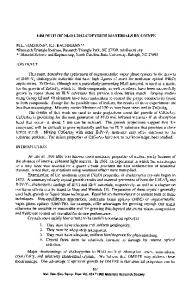Semiorganics: A New Class of Nlo Materials
- PDF / 311,646 Bytes
- 5 Pages / 420.48 x 639 pts Page_size
- 11 Downloads / 349 Views
SEMIORGANICS: A NEW CLASS OF NLO MATERIALS P.R. NEWMAN*, L.F. WARREN*, P. CUNNINGHAM*, T.Y. CHANG*, D.E. COOPER*, G.L. BURDGE**, P. POLAK-DINGELS**, and C.K. LOWE-MA*** * Rockwell International Science Center, Thousand Oaks, CA 91360 ** Laboratory for Physical Sciences, College Park, MD 20740 *** Naval Weapons Center, China Lake, CA 93555
Recent results indicate that certain organic molecules whose electronic structures are characterized by extended pi-molecular orbitals can exhibit significant second and third order nonlinear optical (NLO) effects [1]. Unfortunately, this same arrangement which leads to the NLO effects, can also result in essentially one-dimensional bonding coordination. This in turn means that crystals grown from these materials do not readily form good three-dimensional optical-quality crystals, but rather tend to form needles. In addition, pure organic crystals are usually bonded by weak van der Waals forces, often resulting in poor mechanical properties. Indeed, organic impurities are frequently incorporated into these systems during crystallization resulting in poor crystallinity, spurious absorptions, and low damage thresholds. This is particularly true in the case of polymeric NLO materials, where impurities result from the polymerization steps and/or starting materials. SEMIORGANICS A new approach to high performance, optical quality organic-based NLO materials is to consider compounds in which a polarizable organic molecule is stoichiometrically bonded within an inorganic host forming either an organic/inorganic salt (e.g., LAP [2]) or an organic ligand/metal ion complex. Although such systems have been known for many years, we are the first to examine them for their NLO properties and have coined the term "semiorganics" to refer to them. With semiorganics, the organic component is chosen to possess high molecular hyperpolarizability by virtue of extended pi-orbitals and is bonded chemically within a surrounding inorganic host. The bonding scheme of this inorganic species is three dimensional and can lead to the growth of large opticalquality three-dimensional crystals. The stoichiometric nature of the chemistry associated with these materials results in a much purer material, leading to reduced absorption. NLO Polarizability in Semiorganics Intuitively, one might expect that to first-order, the characteristics of a semiorganic crystal would be described essentially as diluting the effective hyperpolarizability as a result of the decrease in volume fraction of the organic NLO component. Also, it would appear to limit the extent of intermolecular pi interactions by breaking up the organic units. In actual fact, many semiorganic systems have a polymeric character which retains extensive pi molecular orbital interactions between the organic components. Recent theoretical and experimental results in pure conjugated organic polymer systems, however, show that the large hyperpolarizabilities associated with these molecules saturate as the number of monomer units reaches about twenty. In the ca
Data Loading...











